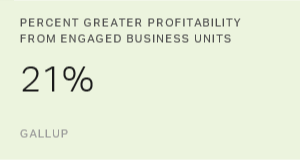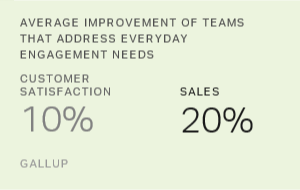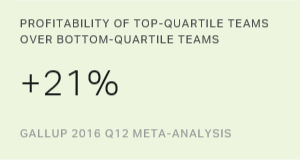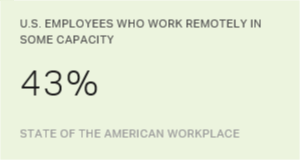Story Highlights
- Measuring workers' contentment doesn't improve business outcomes
- Approaching engagement as a business strategy yields better results
- Highly engaged organizations share common philosophies and practices
Creating a great workplace culture that has star employees who know how to win new customers isn't about making employees happy or content -- and organizations falter when they think it is.
It's true that enthusiastic and energetic employees feel better about their work and workplace. But engagement is not determined by an abstract feeling. Measuring workers' contentment or happiness levels, as well as catering to their wants, often fails to achieve the underlying goal of employee engagement: improved business outcomes.
Organizations have more success with engagement and improve business performance when they treat employees as stakeholders of their own future and the company's future. This means focusing on concrete performance management activities, such as clarifying work expectations, getting people what they need to do their work, providing development and promoting positive coworker relationships.
The majority of the U.S. workforce (51%) is not engaged, according to Gallup's State of the American Workplace report. These employees are indifferent and neither like nor dislike their job. They represent a risk, and that risk can tilt either way -- good or bad.
Many employees who are not engaged want a reason to be inspired. They are the "show me" group that needs an extra push to perform at their best. While positive feelings, such as happiness, are usually byproducts of engagement, they shouldn't be confused with the primary outcomes. Rather, the primary emphasis should be on elements that engage workers and drive results, such as clarity of expectations, the opportunity to do what they do best, development and opinions counting.
A Business Strategy
Approaching engagement as a business strategy yields clear and better results. Last year, Gallup conducted the ninth version of our meta-analysis (a study of studies) to determine the relationship of engagement -- as measured by Gallup's employee engagement survey -- to business-/work-unit profitability, productivity, employee retention and customer perception.
Despite massive changes in the economy and technology, the results of the most recent meta-analysis are consistent with the results of each previous version. Simply put, engaged employees produce better business outcomes than other employees do -- across industries, company sizes and nationalities, and in good economic times and bad.
Business or work units that score in the top quartile of their organization in employee engagement have nearly double the odds of success (based on a composite of financial, customer, retention, safety, quality, shrinkage and absenteeism metrics) when compared with those in the bottom quartile. Those at the 99th percentile have four times the success rate of those at the first percentile.
When compared with business units in the bottom quartile of engagement, those in the top quartile realize improvements in the following areas, among others:
Showing up and staying: Engaged employees make it a point to show up to work and do more work -- highly engaged business units realize a 41% reduction in absenteeism and a 17% increase in productivity. Engaged workers also are more likely to stay with their employers. In high-turnover organizations, highly engaged business units achieve 24% less turnover. In low-turnover organizations, the gains are even more dramatic: Highly engaged business units achieve 59% less turnover. High-turnover organizations are those with more than 40% annualized turnover, and low-turnover organizations are those with 40% or lower annualized turnover.
Customer outcomes: Employees who are engaged consistently show up to work and have a greater commitment to quality and safety. Understandably, these employees also help their organizations improve customer relationships and obtain impressive organic growth. Highly engaged business units achieve a 10% increase in customer ratings and a 20% increase in sales.
Profit: The previous outcomes collide to bring organizations increased profitability. Engaged employees are more present and productive; they are more attuned to the needs of customers; and they are more observant of processes, standards and systems. When taken together, the behaviors of highly engaged business units result in 21% greater profitability.
Creating the Right Culture Is Possible
Employee engagement has long been a concern in the U.S. workforce, but -- perhaps now more than ever -- it represents a vital component of employee attraction and retention. For the modern workforce, an engaging work environment is a fundamental expectation, a baseline requirement. Many employees refuse to settle for an organization that does not strategically prioritize engagement. For leaders, this means a culture of engagement is no longer an option -- it is an urgent need.
Creating a culture of engagement requires more than completing an annual employee survey and then leaving managers on their own, hoping they will learn something from the survey results that will change the way they manage. It requires an organization to take a close look at how critical engagement elements align with their performance development and human capital strategies.
Engaging employees takes work and commitment, but it is not impossible. One-third of the overall U.S. workforce is engaged. And many organizations come to Gallup with even lower percentages of engaged employees -- the median engagement level among our first-year clients is 30%.
But as they shift their approach, these organizations begin to realize improvements in performance. The engagement level among recent Gallup clients is 44%, and it is even higher among clients with the highest levels of engagement -- the winners of the Gallup Great Workplace Award. In these organizations, an average of 70% of employees are engaged, and there are 14 engaged employees for every actively disengaged employee -- a ratio that is seven times the national average.
Highly engaged organizations share common philosophies and practices. Among other things:
- They know creating a culture of engagement starts at the top.
- Their leaders are aligned in prioritizing engagement as a competitive, strategic point of differentiation.
- They communicate openly and consistently.
- They place the utmost importance on using the right metrics and on hiring and developing great managers.
Highly engaged organizations also hold their managers accountable -- not just for their team's measured engagement level, but also for how it relates to their team's overall performance. They ensure that managers are engaging employees from the first minute of their first day at work.
These organizations have well-defined and comprehensive development programs for leaders and managers, and they focus on the development of individuals and teams. Employee engagement is a fundamental consideration in their people strategy, not an annual "check-the-box" activity.




